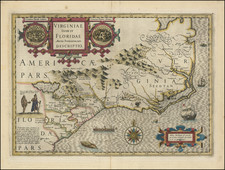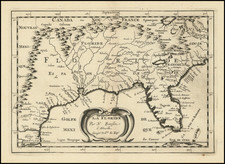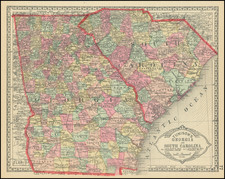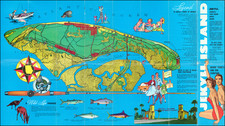Striking, Intricate Map of St. Augustine, From the Atlantic Neptune
Fine example of Des Barres’ massive two-sheet plan of St. Augustine, which featured in his famed and rare sea atlas, the Atlantic Neptune. The town is the oldest continuously-occupied settlement in what is now the United States.
Centered on the town as it was in the 1760s, the map presents a remarkably detailed view of colonial St. Augustine. It stretches from North and South Bar(r) and St. Anastasia Island, to the saltwater Matanza River and St. Sebastians Creek in the south, to North River and Fort Maze. Also included are other area landmarks such as Fort St. Mark, Oglethorp Battery, the Light House, and the quarries on St. Anastasia Island.
The topography is shown in exacting detail, making it easy to distinguish between grassy areas, wooded stretches, and fields under cultivation. Waterways run throughout the landscape. Sandbars are shown to help with navigation in the shallow waters, and numerous high-water soundings line the route into St. Augustine and the Matanza River.
St. Augustine is shown with its defensive walls and ordered streets. The detail extends to the state of development of buildings on each block, capturing the town during the twenty years, 1763-1783, when the British occupied the site.
The surveys for this map were performed by William Gerhard De Brahm, a Georgian colonist originally from Germany. De Brahm was tasked with surveying the coast of the Southern District, with an especial focus on the coastline from St. Augustine to Cape Florida.
This is the second state of the map, which includes more pronounced boundaries around the farms. Unlike other Des Barres’ charts, the St. Augustine chart was prepared exclusively from surveys prepared for the Board of Trade, so it includes significantly more inland details than many of his other works.
The Atlantic Neptune
Upon the conclusion of the Seven Years War, Britain's empire in North America was greatly expanded, and this required the creation of a master atlas featuring new and accurate sea charts and maps for use by the Royal Navy and the Board of Trade. Des Barres was enlisted to survey the coastlines of Nova Scotia, Newfoundland, and the Gulf of St. Lawrence.
With these extremely accurate surveys in hand, Des Barres returned to London in 1774, where the Admiralty charged him with the Herculean task of producing the atlas. He was gradually forwarded the manuscripts of numerous advanced surveys conducted by other British cartographers and hydrographers in the American Colonies, Jamaica, and Cuba conducted in the 1760s.
The result was the Atlantic Neptune, which became the most celebrated sea atlas of its era, containing the first systematic survey of the east coast of North America. Des Barres's synergy of great empirical accuracy with his distinctive artistic style created a work that "has been described as the most splendid collection of charts, plates and views ever published" (Stevens).
The Neptune eventually consisted of four volumes and Des Barres's dedication to the project was such that he continually updated and added new charts and views to various editions up until the mid-1780s, often at his own expense. Overall, he produced over 250 charts and views, many appearing in several variations. All of these charts were immensely detailed, featuring both hydrographical and topographical information; in many cases they remained the most authoritative maps of the regions covered well into the nineteenth century.
This plan featured in vol. IV, part II of the important sea atlas, which included charts from New York to the Gulf of Mexico, as well as ports in Jamaica and Cuba.
The atlas is of the utmost rarity; one of the most recent examples offered at auction sold for $779,000 in 2009.
St. Augustine
Not only was this map part of an important atlas, it also shows one of the most historical cities in the Americas. The Spanish first came to this part of Florida in 1513, when Ponce de León claimed the land in the name of Spain, despite the presence of indigenous groups. It is the oldest continuously-occupied European settlement in what is now the United States; only Puerto Rico has older establishments in territory controlled by the United States.
Both Spain and France attempted to begin settlements in Florida in the early and mid-sixteenth century. St. Augustine was founded in 1565, only after the Spanish destroyed a rival French contingent at Fort Caroline, on the St. Johns River. While returning to St. Augustine, the Spanish encountered and killed a band of French soldiers near Anastasia Island, earning the name “Matanzas,” or massacre, for the inlet seen on this map.
In 1566, Martín de Argüelles was born at St. Augustine, making him the first child of European ancestry born in what would become the United States. In 1606, the first birth of a black child in what would become the United States also took place in St. Augustine, as recorded in the Cathedral Parish registry.
Despite earlier expeditions, the Spanish attempts to explore and settle more of Florida was largely unrealized after the founding of St. Augustine. This was due in considerable part to the objections of Native Americans to Spanish incursion. For example, the Saturiwa nation burned the settlement in 1566, causing its relocation. In 1586, danger came from a different source when English privateer Sir Francis Drake sacked St. Augustine. Eighty years later, another English privateer, Robert Searle, raided the town again. In order to protect their toehold in Florida, the Spanish began building the Castillo de San Marcos, or Fort St. Mark. Today, it is the oldest fort in the United States.
As a military outpost, there were not many enslaved people imported to St. Augustine, although black people were certainly present from the town’s earliest days. After the English began their plantations farther north on the Atlantic seaboard, the Spanish began to offer sanctuary to enslaved peoples who escaped to Florida in exchange for their conversion to Catholicism and allegiance to Spain. In 1738, Governor Manuel de Montiano founded the first legally-recognized free community of formerly enslaved peoples, Gracia Real de Santa Teresa de Mose. It was also known as Fort Mose, or Fort Maze as it is written here.
Danger again knocked on the door of St. Augstine in 1740, when General Oglethorpe of Georgia led a campaign against the Spanish. He allied himself with the several bands of Seminoles, former allies of the Spanish. As part of the War of Jenkins’ Ear (1739-42), Oglethorpe besieged St. Augustine, which was the source of the Oglethorp Battery seen here. One of the most important defenses of the town came from Fort Mose, which was commanded by Captain Francisco Menendez. Menendez had twice escaped from slavery. Today, the fort is a designated National Historic Landmark.
After the Seven Years’ War, in the Treaty of Paris of 1763, Spain had to cede Florida to the British in return for the British evacuation of Havana, Cuba. This is why this map locates St. Augustine in Georgia, although the area had their own governor for East Florida. The free black community and the Spanish colonists departed en masse for Cuba, leaving few behind during the British period. In the Treaty of Paris of 1783, Florida returned to Spanish control. The Spanish would continue to occupy the colony until 1821, when it was turned over to the United States.
This is one of the few maps of the area made in the British period of control and it featured in one of the most important atlases of the era. A rare map on the market, it would be a considerable addition to any collection of Florida, Des Barres, or Early America.
Joseph Frederick Wallet Des Barres (1721-1824) was born in either Paris or Basel, Switzerland, to a Hugueont family. He studied under the great mathematician Daniel Bernoulli at the University of Basel before immigrating to Britain, where he trained at the Royal Military College, Woolwich.
Upon the outbreak of hostilities with France in 1756, he joined the British Royal American Regiment as a military engineer. He came to the attention of General James Wolfe, who was impressed with his charting ability. During this period, he also worked with the legendary future explorer, James Cook, on a monumental chart of the St. Lawrence River.
Des Barres is best known for the Atlantic Neptune, was a remarkable, multi-volume set of sea charts and coastal views prepared from recent surveys, some of which were overseen by Des Barres in Nova Scotia after the Seven Years’ War. The maps, charts, and views were prepared under the supervision of Des Barres and employed as many as twenty engravers and assistants. They were produced over the course of a decade, from 1774 to 1784, in time to be used by the Royal Navy in the American Revolution.
After the Revolution, Loyalists were resettled throughout Canada. As part of this process, a new colony was created by separating Cape Breton from Nova Scotia. Des Barres, who already owned extensive lands in the Maritimes, served as lieutenant governor of Cape Breton Island from 1784 to 1787. He later served as governor of Prince Edward Island from 1804-1812.
Des Barres lived an exceptionally long life, even by today's standards, finally dying at age 102. Des Barres' funeral was held at St. George's Round Church in 1824 and he is buried in Halifax.










![[ Carolinas, Georgia, etc ] Virginiae Partis australis, et Floridae partis orientalis, interjacentiumqus regionum Nova Descriptio](https://storage.googleapis.com/raremaps/img/small/89657.jpg)


![Map of the States of Alabama and Georgia [Inset Plan of Savannah]](https://storage.googleapis.com/raremaps/img/small/91838.jpg)
